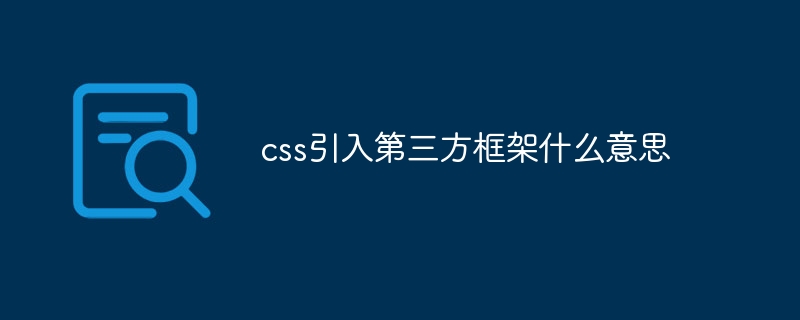Home >Web Front-end >Front-end Q&A >What does it mean to introduce a third-party framework in css?
css The introduction of third-party frameworks refers to the use of CSS style libraries or frameworks from external sources in projects. These third-party frameworks are usually collections of designed and optimized CSS codes to help developers. Quickly build layouts and styles for websites and apps. Reasons for using CSS to introduce third-party frameworks: 1. Save time and improve efficiency; 2. Uniformity and standardization; 3. Community support and updates; 4. Responsive design. By choosing the right framework, following best practices, and optimizing performance, you can achieve better development productivity and results.

The operating system for this tutorial: Windows 10 system, DELL G3 computer.
In web development, the introduction of third-party frameworks into CSS refers to the use of CSS style libraries or frameworks from external sources in the project. These third-party frameworks are usually a collection of designed and optimized CSS codes that help developers quickly build the layout and style of websites and applications.
There are several reasons for using CSS to introduce third-party frameworks:
1. Save time and improve efficiency: Using third-party frameworks can save developers a lot of time and energy, because these frameworks have Pre-designed and optimized, many common layouts and styles are provided. Developers can use these frameworks directly and avoid writing CSS code from scratch.
2. Uniformity and standardization: Third-party frameworks usually have unified and standard styles and layouts, which allows multiple projects to share the same style code. This helps keep the project consistent and maintainable.
3. Community support and updates: Most third-party frameworks have active community support, which means they have continuous updates and maintenance. Other developers in the community can provide feedback, fix bugs, and add new features, which is important for long-term projects.
4. Responsive design: Many third-party frameworks provide responsive design functions, allowing the website to display correctly on different devices and screen sizes. This is very helpful in meeting the responsive needs of modern web design.
When using CSS to introduce a third-party framework, developers need to pay attention to the following points:
1. Understand the framework's documentation and API: Before using a third-party framework, it is recommended to carefully read the framework's documentation Documentation and API to learn about its usage and limitations. This will help avoid unnecessary errors and problems during development.
2. Follow best practices: When using third-party frameworks, developers should follow best practices, such as avoiding global style pollution, component-based development, etc. This will help keep your code maintainable and scalable.
3. Customize and extend frameworks: If necessary, developers can customize and extend the functions and styles of third-party frameworks. This can be accomplished by overriding the framework's default styles, adding new CSS classes, or modifying the source code.
4. Pay attention to performance and loading time: Although using third-party frameworks can improve development efficiency, they may also increase page loading time and rendering performance. Developers should pay attention to optimizing CSS code to avoid unnecessary styles and code redundancy, while using appropriate caching strategies to improve performance.
5. Consider compatibility issues: Different browsers may have different levels of support for CSS. When using third-party frameworks, developers should pay attention to testing and verifying their compatibility in different browsers to ensure that the website can be displayed correctly in various environments.
In short, introducing third-party frameworks into CSS is a common development practice that can help developers quickly build high-quality websites and applications. By choosing the right framework, following best practices, and optimizing performance, you can achieve better development productivity and results.
The above is the detailed content of What does it mean to introduce a third-party framework in css?. For more information, please follow other related articles on the PHP Chinese website!